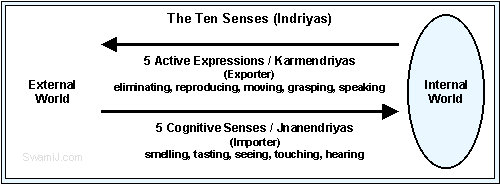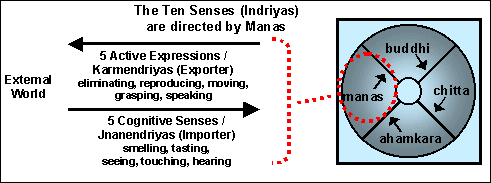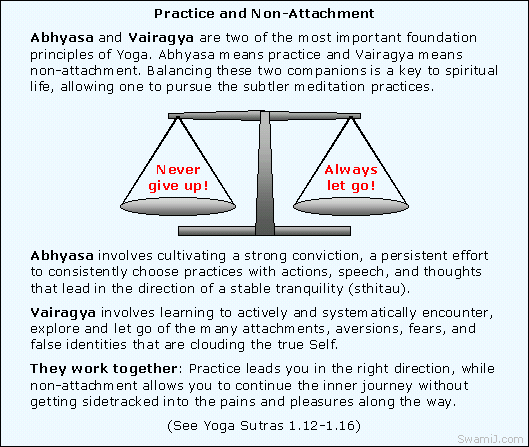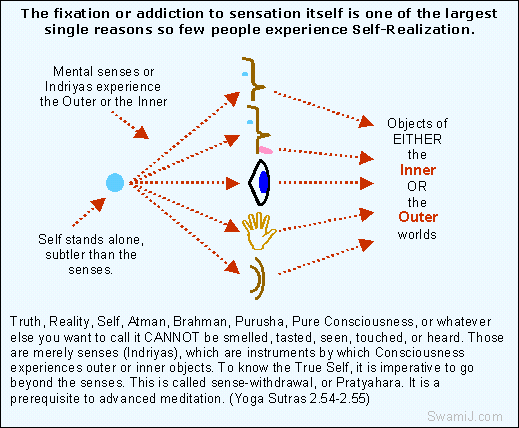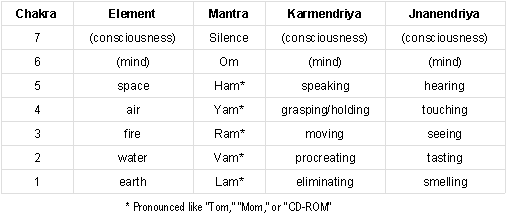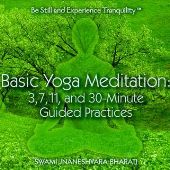|
Home Site Map CDs 4 functions of mind Witnessing Thoughts Who is witness? |
||||||||||||||||||||||||||||||||||
|
|
Training
the
Ten Senses or Indriyas Like a building with ten doors: In traditional Yoga philosophy and practice, the human being is seen as being like a building with ten doors. Five are entrance doors, and five are exit doors. Consciously, actively and intentionally witnessing these ten senses as they function is an important part of Yoga meditation, and meditation in action.
Contents: See also: The indweller relates through the Indriyas Observe the ten senses during daily life: What the ten doors have in common, is that they are all doors. By observing these ten in daily life through meditation in action, or mindfulness, we become increasingly aware of the indweller. We see more and more clearly how the indweller relates to the external world through the means of these ten instruments.
"I" am independent of actions and senses: As we come to see that the actions and senses are only instruments (though very good at their jobs), we increasingly see that "Who I am is independent of my actions and sensory input and fulfillment". It does not mean that we do not enjoy life, and its actions and sensory experiences. Rather, these are enjoyed more fully, in a spirit of wisdom, freedom, and non-attachment. When we see through direct experience of observation how the ten senses are doors serving the indweller, we increasingly become aware of the true nature of that indweller. Manas and the Ten Senses The ten senses are like employees: The Ten Senses are like the employees in the factory of life, and they receive their instructions from Manas, one of the Four Functions of Mind.
This is an important part of the practice of meditation in action and witnessing our inner process. Being able to see that this is how the actions and senses operate helps a great deal with the cultivation of non-attachment, vairagya. Beyond the fact that Manas is giving instructions to the Ten Senses, is the very important question of whether Manas is acting out of unconscious habits (stored in Chitta) or the wisdom of Buddhi. Withdrawing the senses and sitting still at meditation time naturally come much more easily as a result of an ongoing mindfulness of the ten senses. The senses are not reliable Senses are not reliable instruments: There are three main problems with directly experiencing the Absolute Truth, Reality, or the Self through the vehicles of the mind and the senses. One of these problems is the fact that the senses are not reliable instruments. This leads one inward: Realizing that the senses are unreliable leads the seeker inward to a more pure form of direct experience. However, to turn inward this way happens best by first being aware of the senses and how they operate. Then attention can be withdrawn from the senses, like withdrawing your hand from a glove. An exercise in this is described further below. Synaesthesia Sensory connections can even be crossed: One of the ways that it is easy for us to understand the unreliability of the senses is by considering the neurological disorder called synaesthesia. With this disorder, a person's brain connections are different from the typical. When, for example, light comes in the eyes (normally used for sight), the neurological connections might be to the smelling centers of the brain. Thus, one might experience smell when looking at certain objects, or may hear some particular color. How very different would be our descriptions of external reality if all human brains operated this way. (It is estimated that approximately 1 in 25,000 people naturally experience synaesthesia.) Truth is beyond the senses: With a little reflection on this, you can understand the way in which the yogis are saying that the senses are not really accurate perceptual instruments. You might want to read a bit more about this disorder by searching web pages related to synaesthesia. It is not that this will directly tell you about Yoga in relation to the Indriyas, but will help to clarify the varieties of ways in which the senses might operate, and experience reality differently. This can further help you to understand how it is that the yogis say that Truth must be found within, or beyond the senses. Witnessing the ten senses in daily life Moving is behind, or subtler than walking: To witness the active senses (karmendriyas) in daily life means, for example, that when you are walking you observe that "I am moving". It is not just seeing that "I am walking," but going one step further inward and observing the process of moving that is behind the walking. Then, as you observe different actions and the many ways of moving, you become increasingly aware of the underlying process behind the motion, and this is manas, one of the four functions of mind.
Observe the karmendriya itself: Similarly, if you are using some object, such as when writing with a pen or drinking water from a cup, you notice, "I am grasping" or "I am holding". To be mindful of writing or drinking is one step of the process of mindfulness, but to observe the karmendriya itself is more interior, more subtle. It takes attention inward to the antahkarana (the inner instrument, including the four functions of mind), leading you to be closer to the awareness of the still, silent center of consciousness, like the center of the hub of the wheel. Observing the jnanendriyas: To witness the cognitive senses (jnanendriyas) in daily life means, for example, that when you are walking you observe that "I am seeing" as you navigate around other people and objects. You observe that "I am hearing" when some sound captures your attention. Witnessing the senses leads toward non-attachment: Witnessing the ten senses is a practical tool in coordinating the four functions of mind. By witnessing the ten doors, we are better able to become a neutral witness to all of the inner activities of the mind, and thus be more able to find and rest in the silence beyond, or underneath the mind. This is an important part of cultivating non-attachment. The active senses at meditation time Senses at meditation time: At meditation time, you naturally work with the ten senses in a systematic way. The first part of meditation itself is to work with the five active senses (karmendriyas). Before meditation it is best to empty the bladder and the bowels, and to set aside the expression through the organs of reproduction. That is two of the five active senses, elimination and procreation.
Being aware of the ability to move: Then, you learn to sit still. Sitting still is the setting aside of the karmendriya of moving. Sometimes it seems that sitting still is an act of doing something. Actually, it is not an act, but rather is the absence of an act. Sitting still for meditation is the cessation of the act of moving, the suspension of the use of the active sense, or karmendriya, of motion. In practice, it is extremely useful to sit and be aware of the ability to move, but that you are not using that ability for the present time.
Choosing to not utilize motion or grasping: In the process of meditation one then cultivates a practice of letting go that is often called relaxation practice. This relaxation is also not an act unto itself. There may be particular methods associated with the practice, but it is actually a practice of cessation of that act of holding on or grasping, which is the suspension of one of the active senses, or karmendriyas. In practice, it is extremely useful to sit and be aware of the ability to hold or grasp, but that you are not using that ability for the present time.
The ability to form words, but not doing so: At meditation time it is a common complaint that the mind is chattering and that it won't shut up. Often, people get into fights with the mind over this. The act of quieting the mind is not actually an act in itself. Rather, it is the absence of an act. Being quiet for meditation is the cessation of the act of forming words, the suspension of the use of the active sense, or karmendriya, of speaking. In practice, it is extremely useful to sit and be aware of the ability to form words, but that you are not using that ability for the present time. Karmendriyas and the chakras: The five active senses, or karmendriyas, operate from the lower five chakras (scroll down to see the section further below), and thus can be explored in a systematic sequence. In other words, you might want to practice awareness of the five in the order of gross to subtle, like this:
By being aware of each of the five active senses, karmendriyas, one at a time, and that you are temporarily ceasing to use those abilities for now, attention will naturally move inward, in the direction of meditation. As your attention moves through the five active senses, your attention might naturally be drawn to the physical parts of the body that symbolizes the particular karmendriya.
The cognitive senses at meditation time Interplay between active and cognitive senses: As the five active senses are being settled, attention naturally shifts to the cognitive senses. The two sets of Indriyas, the active and cognitive senses, have a great deal of interplay between them. Once the active expressions are stilled somewhat, the cognitive senses seem to become more noticed. Often the active senses of expressions (karmendriyas) are so busy, that the cognitive senses can be overpowered and less easily witnessed. In other words, if you're having trouble sitting still and the mind is chattering, it is hard to sit quietly and work with the practices of seeing, feeling sensation, and hearing internally.
Witnessing the cognitive senses: The section above described the witnessing of the active senses. In a similar way, you can also practice witnessing the cognitive senses. The ability to smell: The awareness of the sense of smell automatically draws your attention to the nose from where you smell, from the physical perspective (though it actually operates from the first chakra). You are not trying to smell anything in particular, but rather, be aware of the sense of smell itself. You become aware of the ability to smell, and then you set aside that ability. The ability to taste: The sense of taste automatically draws your attention to the mouth, where the physical taste buds are located (though operating from the second chakra). It is not just that you are trying to taste something in particular, though that might happen. Rather, it is awareness of the sense of taste itself. You become aware of the ability to taste, and then you set aside that ability. The ability to see: Awareness of the sense of sight draws your attention to the eyes (though actually operating from the third chakra, the fire center). Here, you are not trying to be aware of objects that you might see with the eye, even the inner eye, but rather, you are being aware of the seeing ability itself. You become aware of the ability to see, and then you set aside that ability. The ability to touch: When you become aware of the sense of touch, that cognitive sense automatically draws your attention to some part of the skin, where the sensory nerves are located (though the sense operates from the heart center, where you feel). It is not a question of what object you might be feeling, but of the sense of touch itself. You become aware of the ability to feel with touch, and then you set aside that ability. The ability to hear: The sense of hearing automatically draws your attention to the ears, where the complex physical structure of hearing is located (though operating from the throat chakra, the same place as speaking). As you become aware of hearing itself, rather than listening to specific external sounds, you will also become aware of the inner sounds, though trying here to be aware of the hearing process itself. You become aware of the ability to hear, and then you set aside that ability. First the senses; then move inward: By being aware of each of the five cognitive senses, jnanendriyas, one at a time, and that you are temporarily ceasing to use those abilities for now, attention will naturally move inward, in the direction of deeper meditation. (Note that the cognitive senses are more interior, or subtler than the active senses, which is described in a section below.) Some meditation schools emphasize one Indriya: One currently popular school of meditation places it's main emphasis on this sensory awareness of touch, and how this is experienced in the physical body as a reflection of the mental process. Some other well known schools of meditation emphasize the sense of touch of the air at the nostrils when breathing. Still others emphasize using the senses to see some visualized object or hear an internal mantra. Or, some teach the practice of seeing into the no-thing-ness, or listening into the silence. In the Yoga meditation of the Himalayan tradition, all of these uses of the jnanendriyas are practiced, and are considered natural stages along the inner journey to the center of consciousness. While exploring them all, an individual practitioner may emphasize a particular sense, following his or her predisposition. Pratyahara, or sense withdrawal: In the ladder of Yoga, there are eight steps, the fifth of which is pratyahara. Pratyahara means withdrawal of the senses. Following that are dharana (concentration), dhyana (meditation), and samadhi (deep absorption). This withdrawal of the senses is often taken to mean simply the process of closing your eyes for meditation. It is actually deeper than that. In practice, one may choose one of the senses, usually seeing or hearing, and focus that one sense on an inner object of meditation. (To focus sight on an external object is called trataka.)
Like taking a hand out of a glove: This process being described above, wherein the ability to use the mental functioning of the five active and cognitive senses is being suspended is the deeper meaning of sense withdrawal. It is as if each of the senses is like a glove, and consciousness is being withdrawn. Withdrawal of the senses is like taking a hand out of a glove. When the ten Indriyas are withdrawn, you encounter the mind itself, wherein the real practice of concentration begins, that leads you to meditation and samadhi.
The cognitive senses are more interior
Chakras and the Elements The ten Indriyas operate from the first five chakras (root, genital, navel, heart, throat), along with the five elements:
The mind, operating from the 6th chakra that is experienced in the space between the eyebrows, is the coordinating center for the lower five chakras. From this 6th chakra, the mind is the recipient of the information imported through the five doors of jnanendriyas, and their physical counterparts. From this 6th chakra, the mind is also the giver of the instructions through the five doors of karmendriyas, and their physical counterparts. Consciousness itself is operating from the 7th chakra, providing the fuel or energy for the mind to operate, and in turn illuminate the other five, through it's storage battery at the base of the subtle spine.
By being ever more mindful of the ten Indriyas, or ten senses, the mind comes into greater awareness and control, which prepares the pathway upwards to the pure Consciousness. A practice in awareness of the Indriyas Attention in a particular chakra: A practical way to be mindful of the relationship between the chakras and the ten Indriyas is to focus your attention on a particular chakra. With attention on that chakra, allow yourself to be aware of either the associated active sense or cognitive sense. In your own experience, you will come to see the relationship between that chakra and the specific Indriya. One way to systematically do this practice is to:
Old and new habits: By cultivating awareness of the ten senses, or Indriyas, both at meditation time and in daily life, the whole of the science of Yoga meditation will be more greatly understood in your own direct experience. This awareness goes a long way in serving to break old habits and to create new habits that support the whole of your spiritual life. Withdrawal of the senses - pratyahara The ten senses turn inward: For meditation, it is necessary to withdraw, or turn inward the ten senses (the karmendriyas and jnanendriyas). Often a student of meditation will wonder such things as:
Rung 5 of 8: Each of these are questions related to pratyahara, the turning inward, or withdrawal of the ten senses, or Indriyas. In Yoga, there are eight rungs or steps, of which pratyahara, sense withdrawal is step 5 of 8 (See Yoga Sutras 2.54-2.55). It comes just after numbers 3 and 4, which deal with establishing sitting posture and regulating breath and prana. Step 1 is the 5 yamas, which deal with our relationship with the world. Step 2 is the 5 niyamas, which deal with self-regulation. Pratyahara comes just before steps 6, 7, and 8, which are concentration, meditation, and samadhi.
The ten senses follow the queen bee: In commenting on Patanjali's description of pratyahara in the Yoga Sutras (2.54), sage Vyasa gives a great description of the process, saying pratyahara is like the way bees will follow the queen bee when she comes to rest. Similarly, the Indriyas, or senses, will follow the mind in the same way that the bees follow the queen bee. Where the mind goes, the senses will follow. Thus, the key to withdrawal of the senses is the one-pointedness of the mind (ekagra; see Yoga Sutra 1.32). It is not so much that withdrawing the senses leads to regulation of the mind. Rather, it is a case of focusing the mind bringing the senses inward.
Unwillingness to withdraw the senses: It is very common for people to be completely unwilling to withdraw the senses, even to the point of intense anger at any suggestion to do so. We can so cling to our sensory experience and the senses themselves that we might insist that being in nature is called meditation, that listening to music is called meditation, or that having internal visions is called meditation. Clinging to the senses does not just mean that we are engaged with the objects of the external world. Withdrawal of the senses for meditation does not just meaning closing the eyes and sitting in a quiet room. Rather, the clinging has to do with attachment to the process of sensing itself, and withdrawal of the senses literally means the cessation of seeking the sensing experiences through those senses, in relation to both external physical objects and internal mental objects. It means suspending all use of the inner instruments of smelling, tasting, seeing, touching and hearing, whether directed to the outer or the inner. The willingness or unwillingness to be open to this withdrawal is a significant dividing line between those who experience the depths of meditation and those who merely achieve some degree of mental relaxation. Very few will opt for the depths of meditation, which comes with sense withdrawal or pratyahara. With preparation, pratyahara comes naturally: Pratyahara, withdrawal of the senses, rests on the foundation practices of purifying the mind through regulating lifestyle, dealing with the body and breath, each of which are done with one-pointedness of mind. It involves exploration and focus on the ten senses themselves, as instruments, as described in the sections above. Then, the withdrawal of the senses comes naturally, and leads to concentration, which, in turn, will lead to meditation with practice. Knowing you exist beyond the senses Self-awareness does not depend on the senses: If you hold your hand out in front of you, you know that you have fingers because you see them. But if you close your eyes, you still know that you have fingers. If you have withdrawn all of your senses inward, you still know that you exist. This is because of the self-awareness that is not dependent on the senses. To advance, let go of the imagery and sensing: In meditation, you withdraw the senses. At first, you might be aware of the objects of the senses and the senses themselves. But for advancing in meditation, you let go of all of this imagery and sensing. You rest in a deep stillness and silence, without any sensory experience, either from the external world or from the thought patterns arising from the basement of the mind. Sensory awareness is one of the stages: Awareness of objects, senses, and inner experiences are stages along the journey of meditation. However, ultimately, you want to dwell in the knowing that is beyond, or interior to all of these. It is the doorway to the realization of the formless, colorless Self, the center of consciousness.
-------
|
|
||||||||||||||||||||||||||||||||

